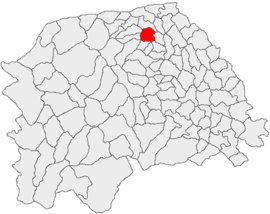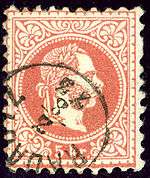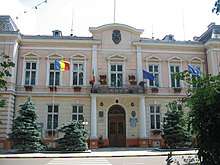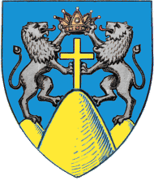Rădăuți
Rădăuți (Romanian pronunciation: [rədəˈut͡sʲ]; German: Radautz; Hungarian: Radóc; Polish: Radowce; Ukrainian: Радівці, Radivtsi; Yiddish: ראַדעװיץ Radevits; Turkish: Radoviçe) is a city in Suceava County, north-eastern Romania. It is situated in the historical region of Bukovina. Rădăuți is the third largest urban settlement in the county, with a population of 23,822 inhabitants, according to the 2011 census. It was declared a municipality in 1995, along with two other cities in Suceava County: Fălticeni and Câmpulung Moldovenesc. Rădăuți covers an area of 32,30 km² and it was the capital of former Rădăuți County (until 1950).
Rădăuți | |
|---|---|
Union Square in downtown Rădăuți | |
 Coat of arms | |
 Location in Suceava County | |
 Rădăuți Location in Romania | |
| Coordinates: 47°50′33″N 25°55′9″E | |
| Country | |
| County | Suceava |
| Government | |
| • Mayor | Nistor Tătar[1] (PSD) |
| Area | 32.30 km2 (12.47 sq mi) |
| Population (2011)[2] | 23,822 |
| • Density | 740/km2 (1,900/sq mi) |
| Time zone | EET/EEST (UTC+2/+3) |
| Vehicle reg. | SV |
| Website | Official site |
Administration and local politics
Town council
The town's current local council has the following political composition, according to the results of the 2016 Romanian local elections:
| Party | Seats | Current Council | |||||||
|---|---|---|---|---|---|---|---|---|---|
| Social Democratic Party (PSD) | 7 | ||||||||
| National Liberal Party (PNL) | 5 | ||||||||
| Alliance of Liberals and Democrats (ALDE) | 3 | ||||||||
| People's Movement Party (PMP) | 2 | ||||||||
| Union for Rădăuți (UPR) | 2 | ||||||||
Geography
Rădăuți is situated in Bukovina, on a plain between the Suceava and Sucevița rivers, 37 km (23 mi) north-west from Suceava, the county capital. The city is located in the depression with the same name, at 375 metres (410 yards) altitude. It is one of the oldest settlements in Moldavia, known since the 15th century. The towns of Siret, Solca, Milișăuți and Vicovu de Sus are located relatively close to the city, in the Rădăuți urban area of influence.
Demographics
| Year | Pop. | ±% |
|---|---|---|
| 1910 | 16,535 | — |
| 1930 | 16,788 | +1.5% |
| 1948 | 14,530 | −13.5% |
| 1956 | 15,949 | +9.8% |
| 1966 | 18,580 | +16.5% |
| 1977 | 21,869 | +17.7% |
| 1992 | 31,074 | +42.1% |
| 2002 | 27,633 | −11.1% |
| 2011 | 23,822 | −13.8% |
| Source: Austrian and Romanian census data and/or official estimates | ||
Rădăuți reached its peak population in 1992, when more than 31,000 people were living within the city limits. As of 2016, the town of Rădăuți was the second most populated urban settlement in Suceava County, after the county capital, Suceava.[3]
At the 2011 census, Rădăuți had a population of 23,822 inhabitants: 96.97% of inhabitants were ethnic Romanians, 0.89% Russians and Lipovans, 0.88% Roma, 0.54% Ukrainians and 0.23% Germans (Bukovina Germans). 83.4% were Romanian Orthodox, 9.1% Pentecostal, 3.1% Roman Catholic, 0.9% stated they belonged to another religion, 0.8% were Greek-Catholic and 0.7% each Baptist and Lipovan Orthodox.
History

The mention of "Radomir's village" (as part of a review of boyar property in the area) in a 1392 document (uric) is generally believed to be the town's first mention, and indication of the origin of the name Rădăuți (other theories state that the settlement had its origins in earlier periods, and that the name is a Slavic-influenced derivative of the Latin word Rottacenum, as allegedly used by soldiers in the Roman garrison in Siret).[4] The oldest mention of Rădăuți as such dates from 1413, in a document issued by Moldavian Prince Alexandru cel Bun.
By the middle of the 14th century, Rădăuți was already a flourishing settlement, the seat of a prominent Eastern Orthodox church during the times of Bogdan I (1359–1365), and subsequently a bishopric. Around the St. Nicholas church (Bogdana Monastery), archaeologists have uncovered a habitation layer preceding Bogdan's period of rule, one which could point to the existence of a local center prior to the foundation of Moldavia.
Awarded the privilege of organizing fairs, Rădăuți evolved due to its favorable location midway between the Carpathians and the tableland area (with traders from both regions establishing contact in the local market). The fairs at Rădăuți have been dated to the time of Stephen the Great (a document from 1481; however, since the mention includes details of Stephen's intervention in solving a commercial dispute, it is possible that the fairs were well established by then).
Rădăuți has a cathedral (built 1402) with the tombs of several Moldavian princes.[5] Rădăuți was also the seat of a Greek bishopric, moved to Chernivtsi in 1786.[5]
Rădăuți was one of the largest cities of the Duchy of Bukovina during the period of Habsburg administration (1775–1918). During that time it saw a high level of German (especially Swabian) immigration, which would later form the basis for the Bukovina Germans in the whole region.
Jewish history of Rădăuți
A Jewish community was present before the Habsburg takeover, and is attested to have been overseen by a starost.
Many Jews fleeing the Kingdom of Galicia and Lodomeria (as well as other Habsburg areas) from intense persecution and anti-Semitism during the Middle Ages settled in Rădăuți. The community was allowed a degree of self-administration, and witnessed a period of prosperity and cultural effervescence during the 19th century.
The majority of Rădăuți's Jewish population was exterminated during the Holocaust. Persecutions became widespread around 1938, when Jews were harassed and attacked by authorities under the Octavian Goga government; they were confirmed by anti-Semitic legislation passed by the Ion Gigurtu cabinet, and, in late 1940, exceptionally violent following the establishment of the National Legionary State. In October 1941, all Jews present in Rădăuți (more than 10,000) were deported to concentration camps in Transnistria.[6]
Bogdana Monastery
The Princely Church at Rădăuți contained the graves of Bogdan I and his son Lațcu, both Voivodes/Princes of Moldavia, as well as a later ruler, Roman I of Moldavia. Is the oldest monastery from Moldova and Bucovina (1365). Inside the monastery there are 14 tombs (like Bogdan I (1359–1365), Lațcu Voievod (1365–1373), Roman I (1391–1394), Ștefan I (1394–1399), Bogdan, the brother Alexandru cel Bun, Bogdan, son of Alexandru cel Bun and others.
Natives
- Avigdor Arikha - Israeli painter
- Emil Armin - American artist
- Alexandru Bodnar - athlete
- Heinrich Gärtner - cinematographer
- Irina Lauric - sprint canoeist
- Iacov Putneanul - Metropolitan
- Saint Bishop Leontie of Rădăuți
- Benedict Menkes - Romanian biologist
- Dan Pagis - Israeli Hebrew poet and literature researcher
- Lothar Rădăceanu - journalist, linguist, socialist, and communist politician
- Ștefan Rusu - Olympic champion in Greco-Roman wrestling
- Matei Vișniec - Romanian poet and playwright living in France
Gallery
 The Town Hall
The Town Hall- Former prefecture building in Union Square
- Eudoxiu Hurmuzachi High School
- Queen Elizabaeth Elementary School
 The Ethnographic Museum
The Ethnographic Museum The Romanian Commercial Bank
The Romanian Commercial Bank- CFR train passing through the town
- Bogdan I Equestrian Statue, by Marius Butunoiu
 Bogdana Monastery
Bogdana Monastery The Orthodox Cathedral
The Orthodox Cathedral The Roman Catholic Church
The Roman Catholic Church- The Jewish Temple
References
- "Results of the 2016 local elections". Central Electoral Bureau. Retrieved 3 April 2020.
- "Populaţia stabilă pe judeţe, municipii, oraşe şi localităti componenete la RPL_2011" (in Romanian). National Institute of Statistics. Retrieved 4 February 2014.
- "Populaţia României pe localitati la 1 ianuarie 2016" (in Romanian). INSSE. 6 June 2016. Archived from the original on 2017-10-27. Retrieved 27 October 2017.
- Winkler, Lawrence (2012). Between the Cartwheels (Orion's Cartwheels Book 2). Google Books. p. 378. ASIN B009JDN4ES. Retrieved January 10, 2017.
- Chisholm, Hugh, ed. (1911). . Encyclopædia Britannica. 22 (11th ed.). Cambridge University Press. p. 783.
- "Translation of Rădăuți chapter from Encyclopedia of Jewish Communities in Romania, Vol. 2". Yad Vashem, Jerusalim. 1980. Retrieved January 29, 2013.
- "Primăria Rădăuți - Orașe înfrățite (in Romanian)". Primăria Rădăuți.
External links
| Wikimedia Commons has media related to Rădăuți. |
- (in Romanian) Rădăuți Town Hall official site
- (in Romanian) Rădăuți Online - Unofficial site
- (in Romanian) Rădăuți Info - Unofficial site
- (in Romanian) Eudoxiu Hurmuzachi National High School, Rădăuți
- (in Romanian) The Cultural Authority of Rădăuți
- (in Romanian) Bogdana Monastery official site
- (in Romanian) Gazeta de Monitor - Local newspaper about Rădăuți
- (in Romanian) Suceava County site - Rădăuți web page
- (in Romanian) Photo Gallery - Old photos of Rădăuți
